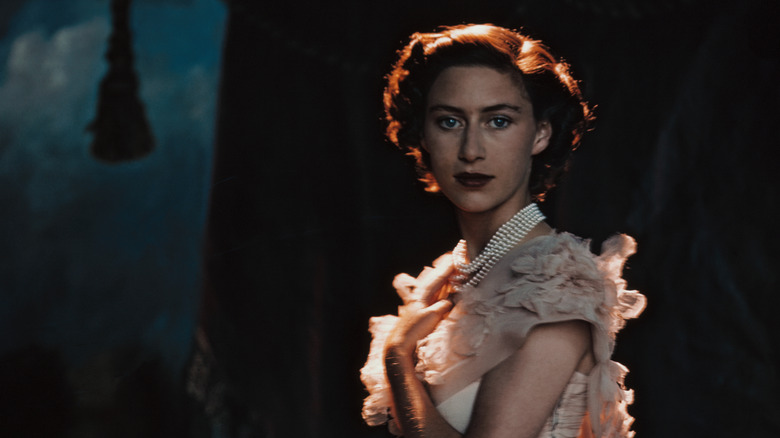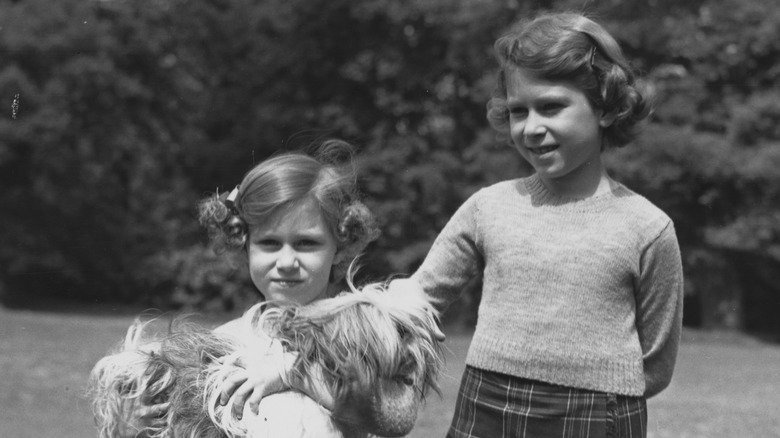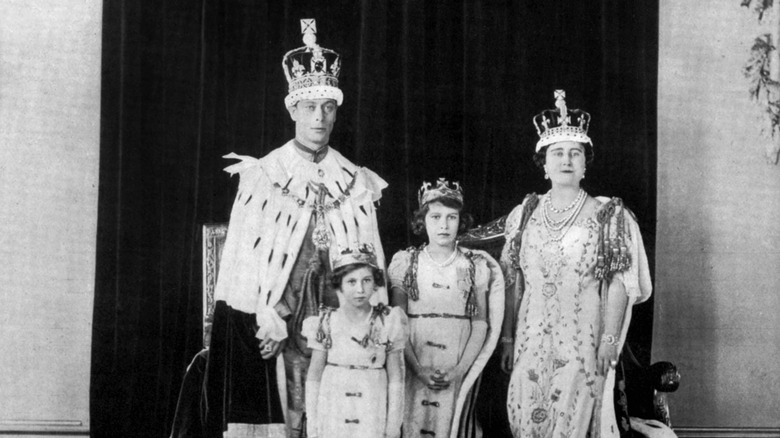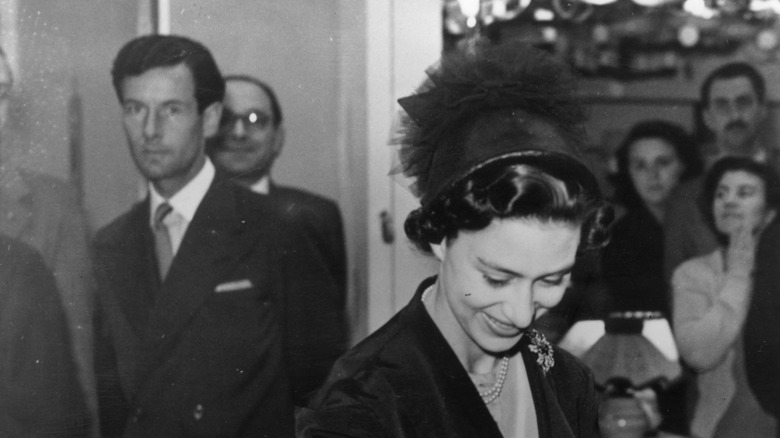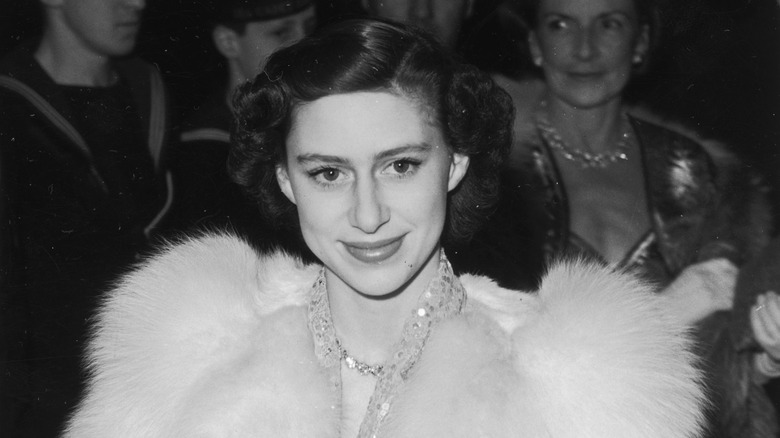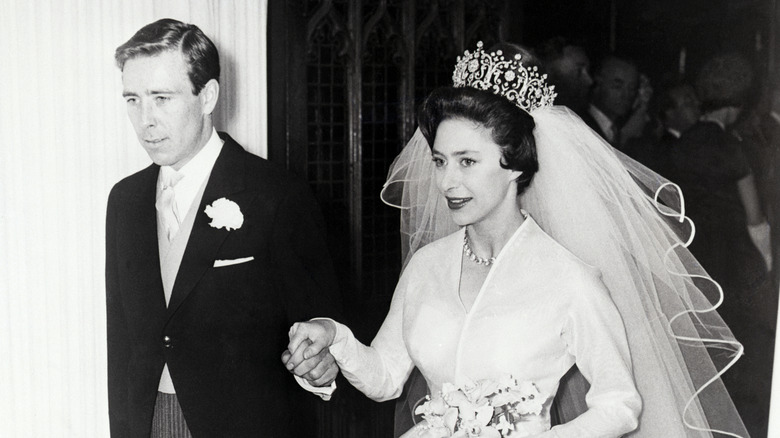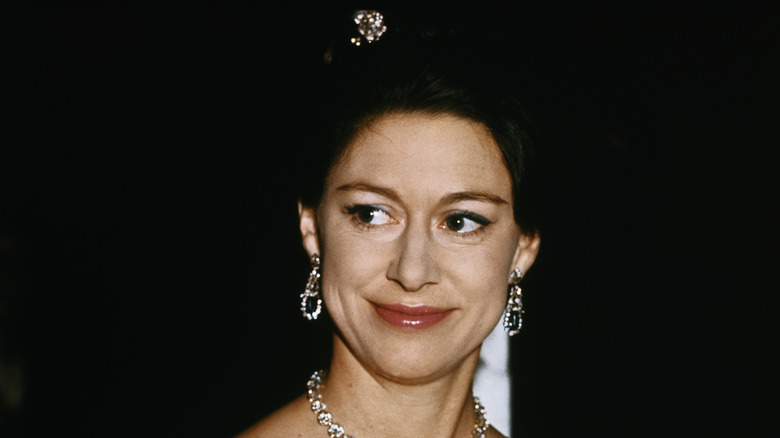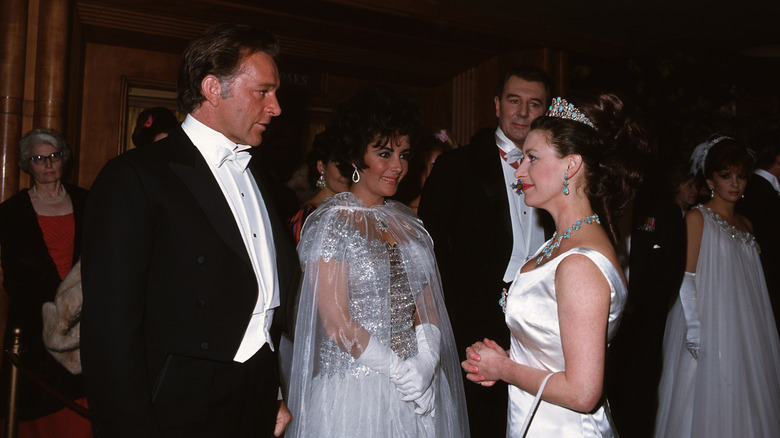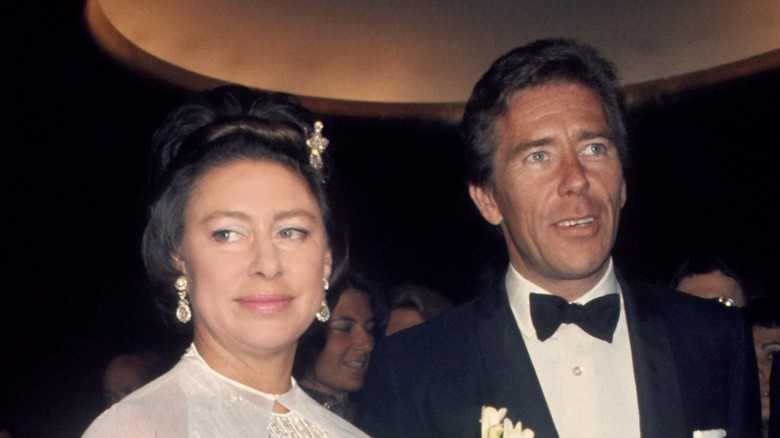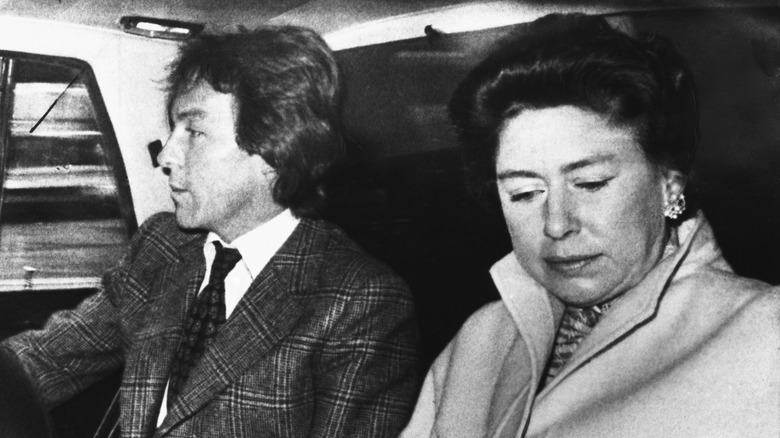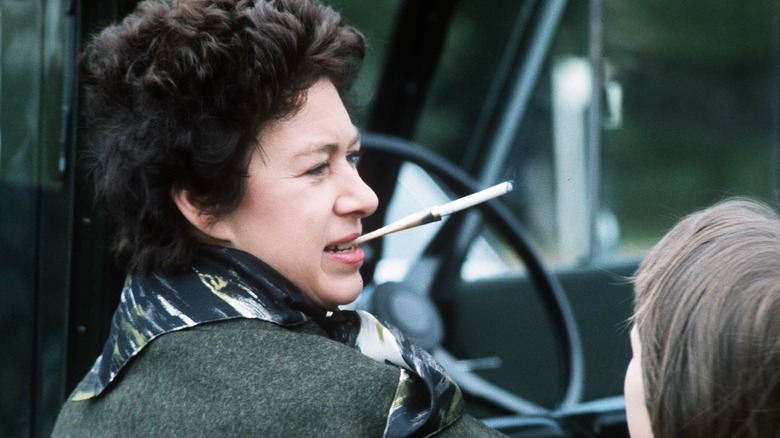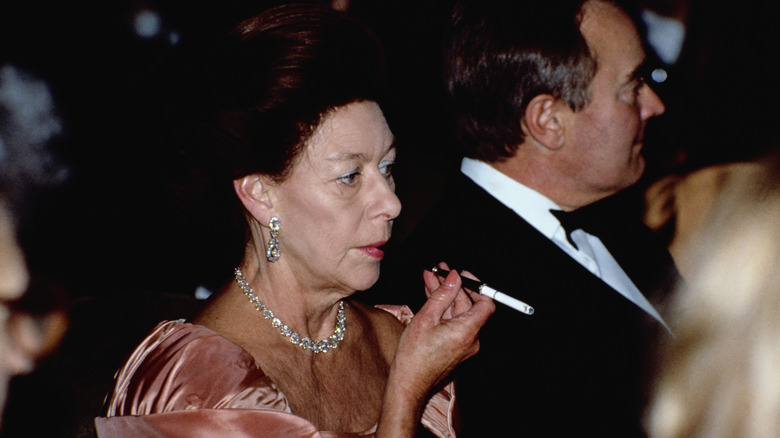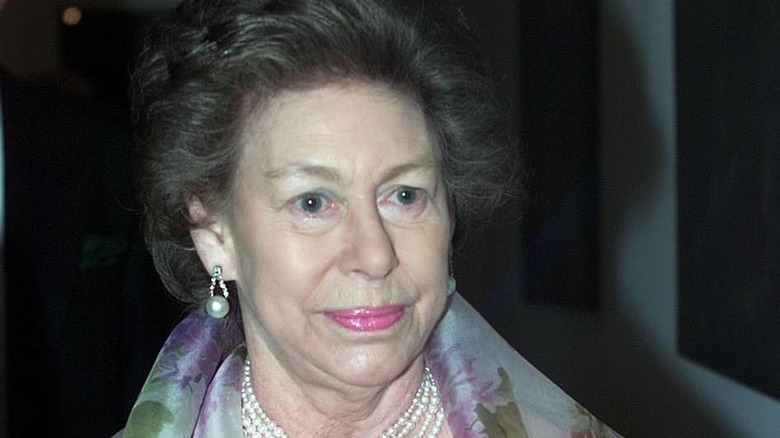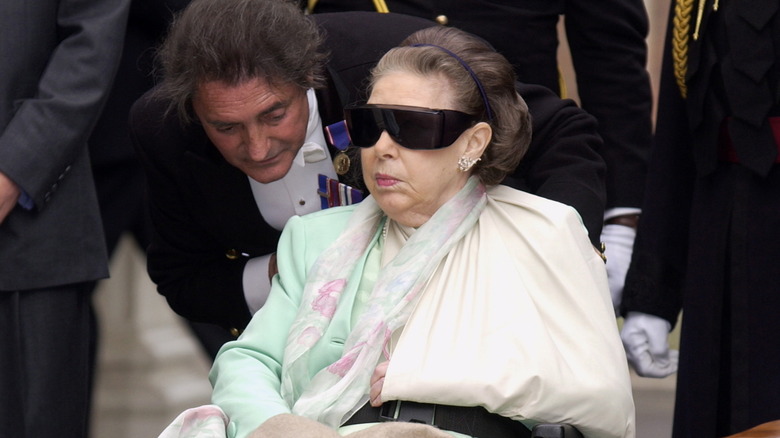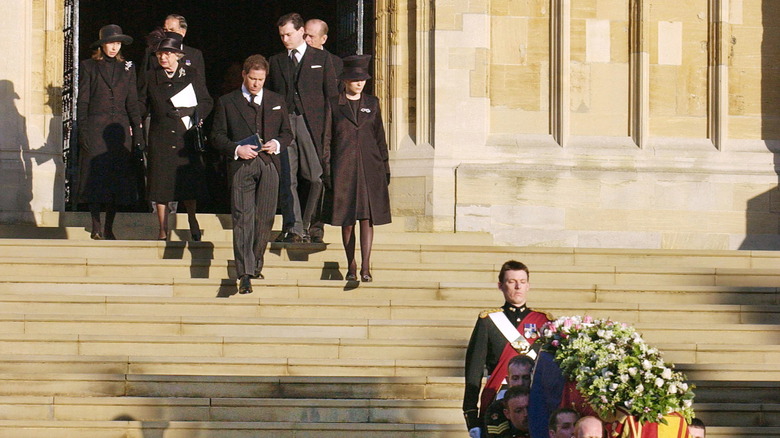The Stunning Transformation Of Princess Margaret From Childhood To 71
The proverbial mold was surely broken after the arrival of Princess Margaret. In her prime, the younger sister of Queen Elizabeth II was one of the most glamorous women in the world, a royal with wit, style, panache, and a wicked sense of humor characterized by withering put-downs and an almost comical level of snobbery. She partied like a rock star — and was rumored to have had flings with a few — and dredged up more than her fair share of scandal over the years. As anyone who's been even remotely paying attention to Britain's royal family over the past 50 years, that's no mean feat, yet Margaret's myriad controversies remain in a class all their own.
Yet Margaret was also a tragic figure. Unlucky in love, her sad final years marred by illness, through it all she maintained a tight bond with her sister. Although Margaret shuffled off this mortal coil more than two decades ago, there's been a renewed interest in the chain-smoking, whiskey-slugging royal thanks to Netflix's "The Crown," in which she's been portrayed — at various stages in her life — by Vanessa Kirby, Helena Bonham Carter and, most recently, Lesley Manville. When the series' sixth and final season made its debut in December 2023, Margaret's death at a far-too-young age was a major storyline. Given her prominence in the Netflix hit as it ends its royal run, read on to experience the stunning transformation of Princess Margaret from childhood to 71.
She and sister Elizabeth were inseparable as children
Princess Margaret entered the world on August 21, 1930, in Glamis Castle in Scotland, the first British royal to be born on Scottish soil in more than three centuries. Four years younger than sister Elizabeth, Margaret immediately entered a life of almost unimaginable wealth and privilege.
The girls and their parents, then the Duke and Duchess of York, formed a tightly knit family, which their father often referred to as "we four." As a result of this closeness, the sisters became close confidants. "They didn't go to regular schools, they were each other's best friend," royal expert Victoria Arbiter said in the documentary "Princess Margaret: Rebel Without A Crown," as reported by the Express. Their dynamic as children, however, was very different from what it would eventually become. "Elizabeth was quite happy for Margaret to be the center of attention because she said, 'If Margaret's there, she makes everybody laugh.' And so it took the pressure off Elizabeth, who perhaps was more introverted compared to her mischievous sister," added Arbiter.
Despite their closeness, the sisters weren't immune to the occasional bit of sibling rivalry. As their former governess, Marion Crawford, wrote in her book, "The Little Princesses: The Story of the Queen's Childhood by Her Nanny," (via Yahoo! Life), "These were two entirely normal and healthy little girls, and we had our difficulties. Neither was above taking a whack at her adversary if roused."
She was thrust into the spotlight by her uncle's abdication
Princess Margaret's life changed dramatically when she was six years old, thanks to the constitutional crisis that ensued where her uncle, King Edward VIII, abdicated in order to marry American divorcee Wallis Simpson. Immediately, her father — a.k.a. Bertie — ascended to the throne as King George VI, coronated in May 1937 in Westminster Abbey.
The life she had known — the daughter of the "spare," enjoying all the royal perks with few of the responsibilities, while staying largely out of the public eye — instantly vanished once her father became king. With her sister first in line for the throne, she became the new "spare" herself. She and Elizabeth, who had previously been on parallel tracks, now found their paths diverging, as the future queen began being groomed for her eventual role as monarch. One experience that both sisters did share, however, was being thrust from relative anonymity to worldwide fame.
When the Second World War began in 1939, the princesses were taken out of London to live in other royal residences, and eventually spent the rest of the war at Windsor Castle. At one point, Royal Central recalled, an idea was floated to ship Margaret and her sister to Canada for their safety, but their mother, Queen Elizabeth, quashed that notion. "The children won't go without me," she famously said. "I won't go without the king. And the king will never leave."
Her scandalous first love was forbidden by her sister
Once Elizabeth became queen, her relationship with Princess Margaret changed due to her dual roles as monarch and head of the Church of England. It was in this capacity that Elizabeth put her foot down after Margaret's 1953 engagement to Capt. Peter Townsend, with whom she'd been involved for several years. By royal standards of the time, Townsend was a thoroughly unsuitable mate; not only was he 15 years older than the 24-year-old princess, he was also married, in the midst of getting divorced. That latter part of the equation was a deal-breaker, given that divorce was prohibited by the Church of England (that rule was eventually relaxed, but not until 2002). When Margaret requested her sister's permission to marry Townsend, she would not grant it.
When Margaret turned 25, she no longer needed the queen's approval; in the meantime, Elizabeth had worked with Parliament to change the Royal Marriages Act so it would permit Margaret to marry a divorced man. There was however, a catch; doing so would remove her from the royal line of succession. Ultimately, Margaret ended the relationship in order to maintain her position in succession. "She could have married me only if she had been prepared to give up everything — her position, her prestige, her privy purse," Townsend wrote in his 1978 memoir, as excerpted by Harper's Bazaar. "I simply hadn't the weight, I knew it, to counterbalance all she would have lost."
She developed a taste for opulence at an early age
It's no secret that Princess Margaret had her vices, primarily cigarettes and booze. She began smoking at 15, a habit she likely picked up from her father, a heavy smoker whose death at 56 was the result of cigarette-related causes; Margaret reportedly puffed up to 60 cigarettes a day.
The tendency to overindulge was evident in her morning routine. According to an excerpt from journalist Craig Brown's book, "Ma'am Darling: 99 Glimpses of Princess Margaret" (appearing in History Extra), after a leisurely breakfast in bed, at 12:30 sharp she started her afternoon with a "vodka pick-me-up before joining the Queen Mother for a four-course lunch, washed down with a half-bottle of wine. In fact, Brown asserted that Margaret devised a clever way to combine her two favorite vices, smoking and drinking, by gluing matchboxes onto glass tumblers so she could strike a match to light a cigarette without having to interrupt her drinking.
Perhaps the most iconic anecdote about Margaret's legendary tippling came from chef Richard Corrigan. As he recalled in 2018 during the GQ Food and Drink Awards, via The Times, he was a culinary consultant for the Concorde while the Princess took a flight. As he recounted, she was so perturbed by the small beverage glasses, she instead grabbed a nearby vase, dumped out the flowers, and rinsed it under a tap. "Now THERE is a glass for my gin and tonic," she declared.
Her royal wedding was the first to be broadcast on television
After ending her romance with Peter Townsend, Princess Margaret fell in love with photographer Antony Armstrong-Jones. The two conducted their courtship in secret before announcing their engagement in 1960. "Nobody knew about their relationship, there wasn't a whisper about it," Anne de Courcy, author of Snowdon: the Biography, told Town & Country. Margaret and Armstrong-Jones were married that same year, with their nuptials becoming the first royal wedding to be televised; the wedding was watched by a worldwide TV audience estimated at 300 million. Armstrong Jones was given the title Earl of Snowdon, which altered Margaret's official title to Her Royal Highness the Princess Margaret, Countess of Snowdon.
The wedding was ostentatious, even by royal standards. Attended by 2,000 guests, the wedding boasted 20 wedding cakes, and a 60-foot arch covered in flowers. Meanwhile, 6,000 police officers were stationed along the route to control the thousands of spectators.
The wedding itself reportedly cost £26,000, significantly more than the £6,000 spent on the wedding of Elizabeth and Prince Phillip; in fact, more than £1,200 of that was spent on liquor and cigarettes. Meanwhile, that cost ballooned by another £60,000 due to the honeymoon, in which the newlyweds took off on a six-week excursion aboard the royal yacht, Britannia, staffed by 20 officers and 237 crew members.
She became the toast of British high society during the swinging '60s
During the heady days of the mid-1960s, Princess Margaret was a fixture in London's social scene, rubbing shoulders with celebrities and members of the British aristocracy.
Margaret was known to use royal protocol to her advantage, arriving late for dinner parties knowing full well that the meal wouldn't be served until she arrived. Then, while dining, she was known to openly disparage the food her hosts served. Whenever she was a houseguest, Margaret pulled similar stunt by overstaying her welcome, drinking and smoking into the wee hours of the morning, with the knowledge that her hosts and the other guests were prohibited from retiring before she did.
It was during this era that Margaret gained a reputation for being haughty, snobby, and downright rude. That was evident in the recollection of model-turned-actor Twiggy, who was seated next to Margaret at a function. Briefed on royal protocol, Twiggy was told not to speak to Margaret until she spoke first. As a result, she found herself ignored by the royal for two hours until she finally addressed her. "Princess Margaret asked, 'What's your name? I said, 'My name's Lesley Hornby, Ma'am, but everyone calls me Twiggy,'" she recalled to the Daily Express. "She just looked at me and said (that accent again) 'Oh, how unfortunate.' Then she didn't talk to me again. I was mortified."
Princess Margaret loved to hobnob with celebrities
Princess Margaret spent decades in the center of star-studded soirees, attending the chicest parties and palling around with celebrities — few of whom were as famous as she was. Stories of Margaret's interactions with stars have become legendary, such as the time she attended a Hollywood party and wound up ticking off Judy Garland, Elizabeth Taylor and Grace Kelly — all during a single evening in 1965.
As the Evening Standard detailed, Taylor and husband Richard Burton exited the party before Margaret even arrived, with the very drunk Burton reportedly furious that they weren't deigned important enough to be seated at the princess's table. Later that night, Margaret encountered Kelly, who by that point had married Monaco's Prince Rainier and was known as Princess Grace. "You don't look like a movie star," Margaret told her fellow princess. "Well," Grace fired back, "I wasn't born a movie star."
Yet Margaret really raised the ire of Garland. According to the Express, Margaret passed along a message to the "Wizard of Oz" star, insisting that she sing for her. Garland reportedly replied, "Go and tell that nasty, rude little princess that we've known each other for long enough and gabbed in enough ladies' rooms that she should skip the ho-hum royal routine and just pop over here and ask me herself." She then added, "Tell her I'll sing if she christens a ship first."
Her marriage to photographer Antony Armstrong-Jones was volatile
While Princess Margaret's wedding to Antony Armstrong-Jones may have been of the fairytale variety, the same cannot be said of the couple's marriage. Unbeknownst to Margaret — and to the public in general until confirmed in 2004 by a DNA test — Armstrong-Jones fathered a child with Camilla Fry, wife of his best friend, in 1960 — the same year he married Margaret. Meanwhile, the couple went on to have two children of their own.
In truth, the spouses' personalities couldn't have been more different. Margaret was accustomed to a life of leisurely loafing; her husband, on the other hand, was something of a workaholic, taking a job as a photographer for the Sunday Times Magazine. Home alone by herself all day, Margaret became obsessed with tracking his whereabouts. The more possessive she became, however, the more he pushed back. Before long, he began taking on assignments that would require him to leave the country. Margaret suspected he was being unfaithful, and she was not incorrect. In 1966, Margaret decided to even the score by having an affair with Anthony Barton, a university friend of her husband's. That wasn't her only infidelity; she was also rumored to have had trysts with actors Peter Sellers, David Niven, and Peter O'Toole, as well as rock star Mick Jagger , among others.
As the years passed, the two drifted further and further apart as they lived increasingly separate lives.
Her affair with Roddy Llewellyn stirred up a royal scandal
Princess Margaret's marriage to Antony Armstrong-Jones reached a tipping point in 1972, when he began an affair with Lucy Lindsay-Hogg (whom he'd later marry). By this point, both spouses had become deeply miserable in their marriage, and made no effort to hide their disdain for each other. In fact, reported the Daily Mail, he began leaving notes for her — in books she was reading, or placed in drawers she'd be likely to open — consisting of all the things that he hated about her. Margaret became an increasingly sullen figure. Recalling her during this period, wrote Sir Roy Strong (via the Mail), "She has no direction, no overriding interest. All she likes is young men."
That proved to be the case when Margaret met Roddy Llewellyn, a gardener and wannabe pop star who was 17 years her junior. They began an affair, which became public knowledge in 1976 when a British tabloid nabbed a photo of the two in an intimate moment. While Llewellyn begged for privacy, the British tabloid press jumped on the affair with gleeful zeal.
Armstrong-Jones, on the other hand, saw the scandal as his ticket out of the marriage he'd come to feel trapped in. He informed Margaret's personal secretary, Lord Nigel Napier, he was leaving her. "Thank you, Nigel. I think that's the best news you've ever given me," the princess said upon hearing the news, as reported by the Evening Standard.
Her divorce was both bitter and historic
In 1978, Buckingham Palace issued a statement to announce that, after being separated for two years, the couple was divorcing. "The marriage has broken down and the couple have lived apart for two years," Margaret's spokesman said in a statement, as reported by The New York Times. "These are obviously the grounds for divorce. Naturally, Princess Margaret and Lord Snowdon will continue to see each other on the same friendly basis as they have with each other over the last two years."
While her televised wedding was historic, so too was Margaret's divorce: as the Times pointed out, the divorce would mark the first divorce of an immediate member of the royal family since 1540, when King Henry VIII had his marriage to Anne of Cleves annulled.
The divorce was finalized later that same year. Interestingly, 1978 also saw the release of "Roddy," Roddy Llewellyn's one and only album. The album was not a hit, and Llewellyn struggled to promote it when journalists' questions were more preoccupied with his relationship with Margaret than with his music. The couple split up in 1981 after eight years together, with Llewellyn initiating the breakup. Later that year he married Tatiana Soskin; there was no bad blood between the exes, with Margaret reportedly giving her blessing to the marriage.
Her heavy smoking caught up with her in her later years
In 1985, Queen Elizabeth's doctors issued a statement. "Princess Margaret underwent an operation at the Brompton Hospital yesterday for the removal of a small area of her left lung which proved to be innocent," the statement read, via Town & Country, with "innocent" taken to mean that whatever had been discovered was not malignant. "Her condition is satisfactory and it's expected that she will leave hospital within the week." Buckingham Palace also issued a statement, reading, "The Queen is very pleased at the satisfactory outcome.
Of course, given her 60-cigarette-a-day habit, few were surprised when it was subsequently revealed that the operation was actually a biopsy, to determine whether Margaret had lung cancer. While there was never any confirmation that Margaret had been diagnosed with cancer, all those cigarettes had left her with pulmonary issues that plagued her for the rest of her life. She reportedly quit after that operation, but resumed smoking a few months later. It wasn't until her 1993 hospitalization for pneumonia that she finally kicked the habit, while also giving up alcohol. As her former lady in waiting, Lady Anne Glenconner, told People, "When she had to give up smoking and drinking more or less at the same time, I admired her and asked her, 'Is it very hard?' She said, 'No, Anne, once I make up my mind to do something I do it. She was practical like that."
A series of strokes left her struggling
In 1998, Princess Margaret suffered the first of what would be several strokes, while vacationing on the Caribbean island of Mustique.
The following year, once again while on Mustique, Margaret had another stroke, which coincided with an awful accident in which Margaret badly scalded her feet in a bathtub. The accident severely restricted her mobility, making walking difficult. As a result, she was forced to use a wheelchair. In addition, that second stroke had also hindered her ability to speak.
She had another stroke in late 2000, while celebrating the Christmas holidays with the rest of the royal family at the Sandringham estate. That one was described as "minor." During Sunday services at the St. Mary Magdalen Church, reported ABC News, Queen Elizabeth told a fellow churchgoer that Margaret was "getting better." Sadly, that didn't actually prove to be the case; she suffered another stroke just a few months later, in March 2001. According to Radio Times, that stroke impacted her ability to swallow, and also caused a loss of vision and paralysis on one side.
Her final years were marred by poor health
In 1996, Queen Elizabeth celebrated her 70th birthday, full of the vim and vigor she would continue to display for the more than two decades she remained on the throne after that. By contrast, Princess Margaret entered her 70s in extremely poor health. Coming back from that second stroke, and the resultant burns, was a long and arduous process. In fact, she never completely recovered, and came to require full-time care. Her lady-in-waiting, Lady Anne Glenconner, became her full-time nurse, watching over her day and night.
Margaret made her final public appearance at the 100th birthday celebration of Princess Alice, the Dowager Duchess of Gloucester, just before Christmas 2001. Confined to a wheelchair, her arm in a sling and wearing dark sunglasses, her face puffy due to medication, Margaret's appearance was a far cry from the glamorous royal who'd swanned about in high society just a decade earlier.
In February 2002, Margaret suffered one final stroke, and was rushed to hospital, experiencing cardiac problems. She died shortly after, aged 71. Buckingham Palace issued a statement to share the sad news with the world. "The queen, with great sadness, has asked for the following announcement to be made immediately," read the statement, reported by CNN. "Her beloved sister, Princess Margaret, died peacefully in her sleep this morning."
Princess Margaret had meticulously planned her own funeral
Just as Princess Margaret was an unconventional rebel in life, so too was she in death. As the Evening Standard reported, Margaret had planned her own funeral, down to the smallest detail, years before. Those plans — which she began putting together after her first stroke — had been locked away in a palace safe until her death.
Her planning had been meticulous, ranging from who she wanted to attend to which hymns would be sung. Friends of the late royal told the newspaper than she wanted her funeral to be a low-key affair, in keeping with the reduced role she was forced to play in her later years due to her myriad health woes. "She wanted her passing to be marked simply and privately, but above all with as little fuss as possible and then for it to be business as usual," a source said.
She also chose to be cremated, yet another break with royal tradition. "Princess Margaret was cremated, one of the first members of the royal family, because she wanted to be buried between her parents and there was only room, really, for ashes," Lady Anne Glenconner said in the documentary "Elizabeth: Our Queen," as reported by Town & Country.

